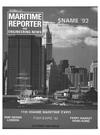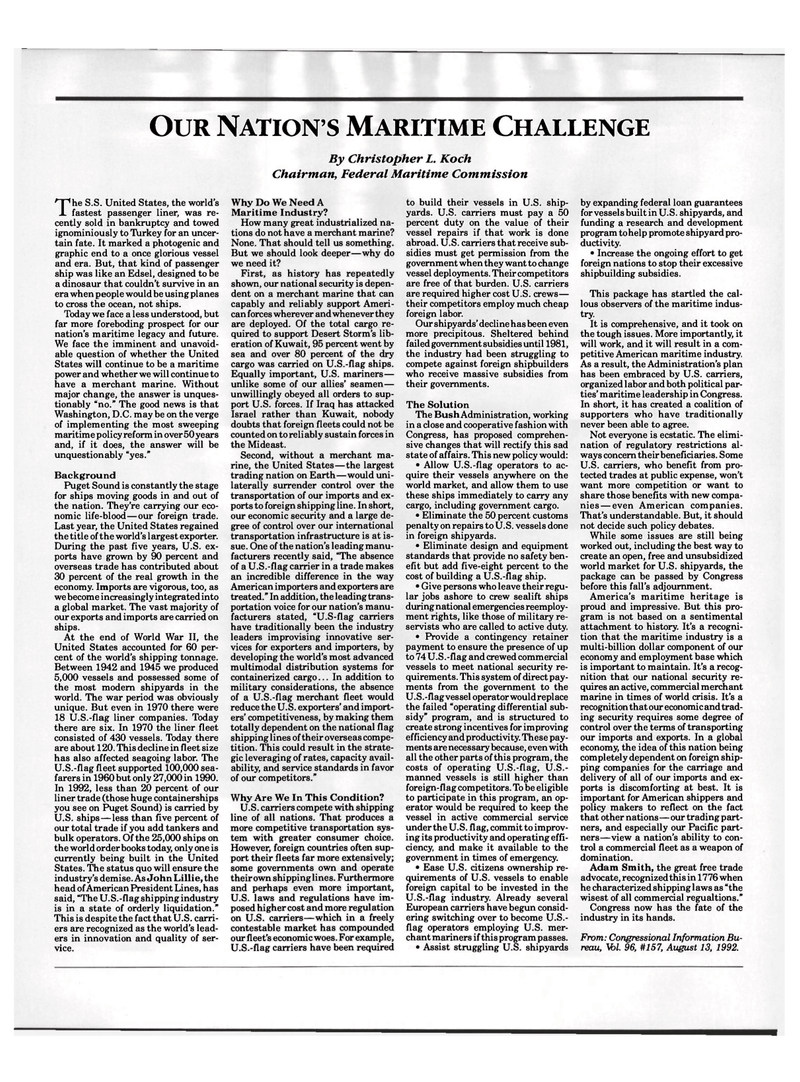
Page 4: of Maritime Reporter Magazine (October 1992)
Read this page in Pdf, Flash or Html5 edition of October 1992 Maritime Reporter Magazine
OUR NATION'S MARITIME CHALLENGE
By Christopher L. Koch
Chairman, Federal Maritime Commission
The S.S. United States, the world's fastest passenger liner, was re- cently sold in bankruptcy and towed ignominiously to Turkey for an uncer- tain fate. It marked a photogenic and graphic end to a once glorious vessel and era. But, that kind of passenger ship was like an Edsel, designed to be a dinosaur that couldn't survive in an era when people would be using planes to cross the ocean, not ships.
Today we face a less understood, but far more foreboding prospect for our nation's maritime legacy and future.
We face the imminent and unavoid- able question of whether the United
States will continue to be a maritime power and whether we will continue to have a merchant marine. Without major change, the answer is unques- tionably "no." The good news is that
Washington, D.C. may be on the verge of implementing the most sweeping maritime policy reform in over 50 years and, if it does, the answer will be unquestionably "yes."
Background
Puget Sound is constantly the stage for ships moving goods in and out of the nation. They're carrying our eco- nomic life-blood—our foreign trade.
Last year, the United States regained the title of the world's largest exporter.
During the past five years, U.S. ex- ports have grown by 90 percent and overseas trade has contributed about 30 percent of the real growth in the economy. Imports are vigorous, too, as we become increasingly integrated into a global market. The vast majority of our exports and imports are carried on ships.
At the end of World War II, the
United States accounted for 60 per- cent of the world's shipping tonnage.
Between 1942 and 1945 we produced 5,000 vessels and possessed some of the most modern shipyards in the world. The war period was obviously unique. But even in 1970 there were 18 U.S.-flag liner companies. Today there are six. In 1970 the liner fleet consisted of 430 vessels. Today there are about 120. This decline in fleet size has also affected seagoing labor. The
U.S.-flag fleet supported 100,000 sea- farers in 1960 but only 27,000 in 1990.
In 1992, less than 20 percent of our liner trade (those huge containerships you see on Puget Sound) is carried by
U.S. ships—less than five percent of our total trade if you add tankers and bulk operators. Of the 25,000 ships on the world order books today, only one is currently being built in the United
States. The status quo will ensure the industry's demise. As John Lillie, the head of American President Lines, has said, "The U.S.-flag shipping industry is in a state of orderly liquidation."
This is despite the fact that U.S. carri- ers are recognized as the world's lead- ers in innovation and quality of ser- vice.
Why Do We Need A
Maritime Industry?
How many great industrialized na- tions do not have a merchant marine?
None. That should tell us something.
But we should look deeper—why do we need it?
First, as history has repeatedly shown, our national security is depen- dent on a merchant marine that can capably and reliably support Ameri- can forces wherever and whenever they are deployed. Of the total cargo re- quired to support Desert Storm's lib- eration of Kuwait, 95 percent went by sea and over 80 percent of the dry cargo was carried on U.S.-flag ships.
Equally important, U.S. mariners— unlike some of our allies' seamen— unwillingly obeyed all orders to sup- port U.S. forces. If Iraq has attacked
Israel rather than Kuwait, nobody doubts that foreign fleets could not be counted on to reliably sustain forces in the Mideast.
Second, without a merchant ma- rine, the United States—the largest trading nation on Earth—would uni- laterally surrender control over the transportation of our imports and ex- ports to foreign shipping line. In short, our economic security and a large de- gree of control over our international transportation infrastructure is at is- sue. One of the nation's leading manu- facturers recently said, "The absence of a U.S.-flag carrier in a trade makes an incredible difference in the way
American importers and exporters are treated." In addition, the leading trans- portation voice for our nation's manu- facturers stated, "U.S-flag carriers have traditionally been the industry leaders improvising innovative ser- vices for exporters and importers, by developing the world's most advanced multimodal distribution systems for containerized cargo... In addition to military considerations, the absence of a U.S.-flag merchant fleet would reduce the U.S. exporters' and import- ers' competitiveness, by making them totally dependent on the national flag shipping lines of their overseas compe- tition. This could result in the strate- gic leveraging of rates, capacity avail- ability, and service standards in favor of our competitors."
Why Are We In This Condition?
U.S. carriers compete with shipping line of all nations. That produces a more competitive transportation sys- tem with greater consumer choice.
However, foreign countries often sup- port their fleets far more extensively; some governments own and operate their own shippinglines. Furthermore and perhaps even more important,
U.S. laws and regulations have im- posed higher cost and more regulation on U.S. carriers—which in a freely contestable market has compounded our fleet's economic woes. For example,
U.S.-flag carriers have been required to build their vessels in U.S. ship- yards. U.S. carriers must pay a 50 percent duty on the value of their vessel repairs if that work is done abroad. U.S. carriers that receive sub- sidies must get permission from the government when they want to change vessel deployments. Their competitors are free of that burden. U.S. carriers are required higher cost U.S. crews— their competitors employ much cheap foreign labor.
Our shipyards' decline has been even more precipitous. Sheltered behind failed government subsidies until 1981, the industry had been struggling to compete against foreign shipbuilders who receive massive subsidies from their governments.
The Solution
The Bush Administration, working in a close and cooperative fashion with
Congress, has proposed comprehen- sive changes that will rectify this sad state of affairs. This new policy would: • Allow U.S.-flag operators to ac- quire their vessels anywhere on the world market, and allow them to use these ships immediately to carry any cargo, including government cargo. • Eliminate the 50 percent customs penalty on repairs to U.S. vessels done in foreign shipyards. • Eliminate design and equipment standards that provide no safety ben- efit but add five-eight percent to the cost of building a U.S.-flag ship. • Give persons who leave their regu- lar jobs ashore to crew sealift ships during national emergencies reemploy- ment rights, like those of military re- servists who are called to active duty. • Provide a contingency retainer payment to ensure the presence of up to 74 U.S.-flag and crewed commercial vessels to meet national security re- quirements. This system of direct pay- ments from the government to the
U. S.-fl a g vessel operator would repl ace the failed "operating differential sub- sidy" program, and is structured to create strong incentives for improving efficiency and productivity. These pay- ments arenecessary because, even with all the other parts of this program, the costs of operating U.S.-flag, U.S.- manned vessels is still higher than foreign-flag competitors. To be eligible to participate in this program, an op- erator would be required to keep the vessel in active commercial service under the U.S. flag, commit to improv- ing its productivity and operating effi- ciency, and make it available to the government in times of emergency. • Ease U.S. citizens ownership re- quirements of U.S. vessels to enable foreign capital to be invested in the
U.S.-flag industry. Already several
European carriers have begun consid- ering switching over to become U.S.- flag operators employing U.S. mer- chant mariners if this program passes. • Assist struggling U.S. shipyards by expanding federal loan guarantees for vessels built inU.S. shipyards, and funding a research and development program to help promote shipyard pro- ductivity. • Increase the ongoing effort to get foreign nations to stop their excessive shipbuilding subsidies.
This package has startled the cal- lous observers of the maritime indus- try.
It is comprehensive, and it took on the tough issues. More importantly, it will work, and it will result in a com- petitive American maritime industry.
As a result, the Administration's plan has been embraced by U.S. carriers, organized labor and both political par- ties' maritime leadership in Congress.
In short, it has created a coalition of supporters who have traditionally never been able to agree.
Not everyone is ecstatic. The elimi- nation of regulatory restrictions al- ways concern their beneficiaries. Some
U.S. carriers, who benefit from pro- tected trades at public expense, won't want more competition or want to share those benefits with new compa- nies— even American companies.
That's understandable. But, it should not decide such policy debates.
While some issues are still being worked out, including the best way to create an open, free and unsubsidized world market for U.S. shipyards, the package can be passed by Congress before this fall's adjournment.
America's maritime heritage is proud and impressive. But this pro- gram is not based on a sentimental attachment to history. It's a recogni- tion that the maritime industry is a multi-billion dollar component of our economy and employment base which is important to maintain. It's a recog- nition that our national security re- quires an active, commercial merchant marine in times of world crisis. It's a recognition that our economic and trad- ing security requires some degree of control over the terms of transporting our imports and exports. In a global economy, the idea of this nation being completely dependent on foreign ship- ping companies for the carriage and delivery of all of our imports and ex- ports is discomforting at best. It is important for American shippers and policy makers to reflect on the fact that other nations—our trading part- ners, and especially our Pacific part- ners—view a nation's ability to con- trol a commercial fleet as a weapon of domination.
Adam Smith, the great free trade advocate, recognized this in 1776 when he characterized shipping laws as "the wisest of all commercial regualtions."
Congress now has the fate of the industry in its hands.
From: Congressional Information Bu- reau, \bl. 96, #157, August 13, 1992.

 3
3

 5
5
